If you’ve been storing and planting seeds for a garden for a few years, you’ve probably at least once, probably early on, learned the lesson of planting or storing seeds incorrectly.
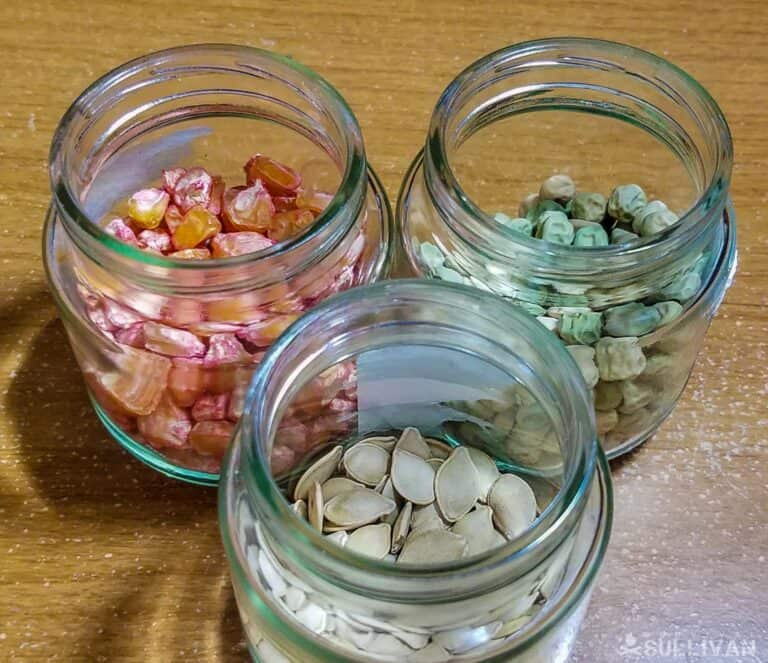
The biggest disappointment about storing or planting seeds improperly is that you don’t find out you’ve done it until they don’t produce.
This can mean not only a delay in getting your garden started but also an unexpected hit to the budget when you have to go and purchase additional seeds to replace the ones which didn’t produce due to your error.
For the most part, any airtight container, made of glass, plastic, or metal can be used to store seeds. Containers for planting seeds are even more diverse.
But while there are many different types of seed storage containers that can hold your seeds safely, there are some other factors depending on your goal for the seeds.
Storage time is another enemy when storing seeds. Most seeds have a shelf life even when stored in optimal conditions.
- Short Shelf Life (1 to 2 years) are things such as peppers, parsley, okra, sweet corn, parsnips, and onions
- Medium Shelf Life (3 to 4 years) are seeds for watermelons, tomatoes, anything in the cabbage family, beans, carrots, beans, celery, pumpkin, squashes, turnips, peas, beets, peas, and spinach
- Long Shelf Life (5 to 6 years) include radish, cucumber, and lettuce seeds.
Containers That Can Hold Your Seeds for Saving
Any container you intend to use to hold your seeds for saving should be airtight, both to keep out oxygen but also to keep out insects. The container itself can be made from plastic, metal, or glass as long as it is indeed airtight.
A simple box with a lid is okay for short-term storage, but it is not going to work too well for long-term storage. If you want to keep seeds for the long haul keeping air out is priority number one.
To properly save seeds, you also need to keep them in an area that is dark, out of direct sunlight, and stays cool without extreme fluctuations in temperature. A shed or garage is a bad spot. A closet in your air-conditioned home is better.
It’s also important to make sure seeds are dry before you place them into your storage container and that the area you choose to store them in is dry as well.
Seeds that snap in half when bent are dry enough for storage. Moisture is the primary enemy when storing seeds. Most seeds come in paper envelopes or seed packets.
You can leave them in the packets or take them out as long as your container is airtight, and consider using silica gel packets in the container itself for better moisture control.
Below are some suggestions for containers that can hold your seeds for saving…
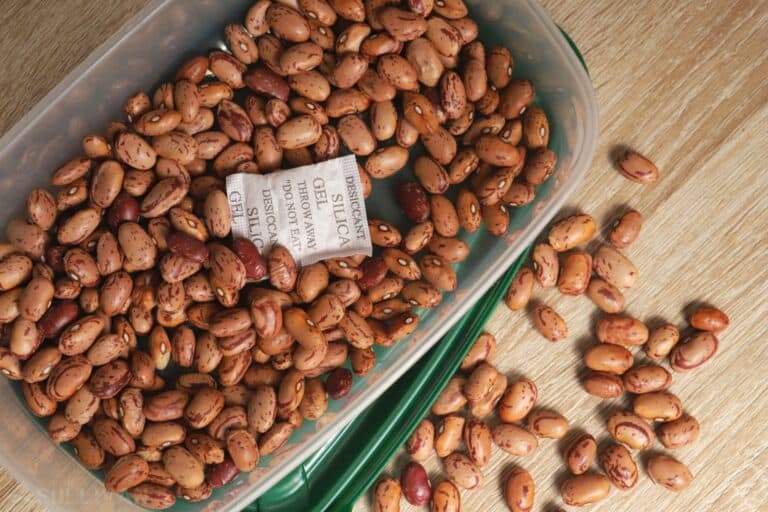
Tupperware containers
Tupperware containers can be your best friend for storing seeds. Sanitary, airtight, easy to organize and easy to stack. Just make sure they are clean and very dry before storing your seeds inside them.
Vitamin bottles
Vitamin bottles have long been a favorite among clever gardeners for storing seeds. They’re just the right size for storing seeds in bulk, and are very easy to store in cabinets or other out of the way places.
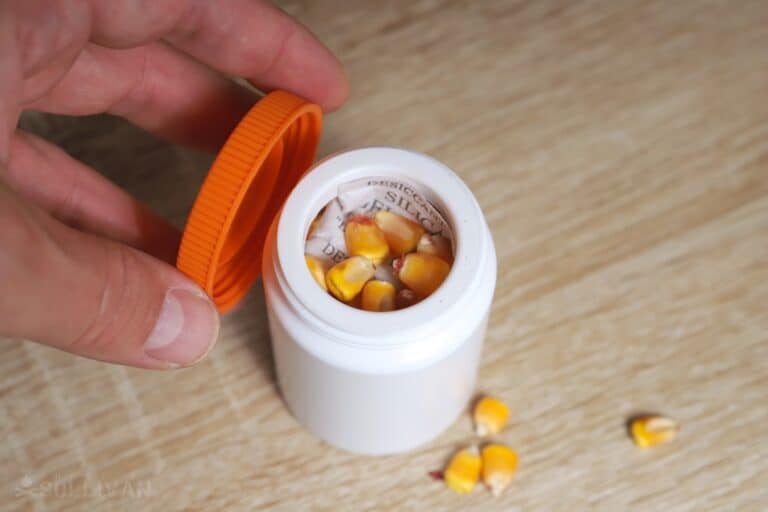
As a rule, these bottles are typically completely opaque which can help protect your seeds from light.
Glass jars
A glass jar is now, as ever, a good option for storage and with the right lid is a great air-tight container.
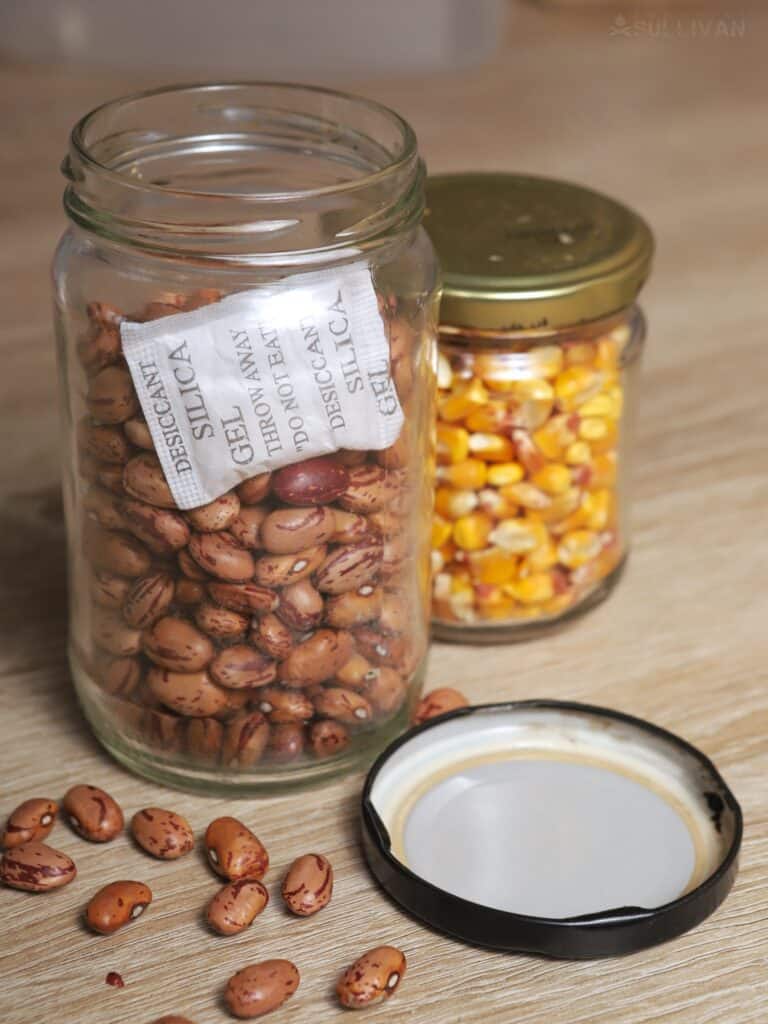
Whether you want to use mason jars or repurposed vegetable or pickle jars always make sure you are starting out with a completely clean interior, and depending on where you are storing them consider blacking out the glass to protect the seeds inside from light.
Ziploc bags
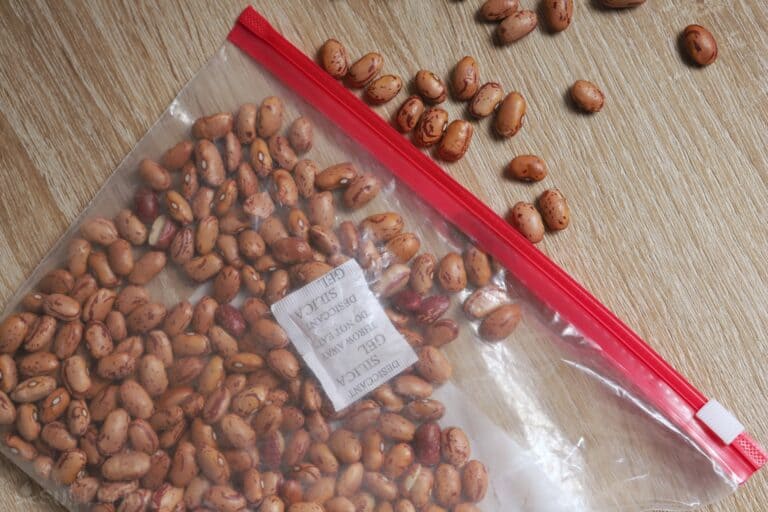
Ziploc bags are another reliable option for storage, and a flexible one. So long as they have a good seal, they will keep air and moisture out. However, if you are storing just a few seeds consider carefully folding them in acid-free paper or something similar to help protect them.
Containers That Can Hold Your Seeds for Starting Plants
When it comes to starting your seeds or planting them, there are a wide variety of containers that can be used. The containers you use to hold your seeds for planting really depend on your budget and your imagination.
The only requirements for containers are that they are at least 2” deep and can provide good drainage.
This means that in addition to all kinds of store bought planters and pots, you can reuse just about anything to hold your seeds for planting.
We’ve listed a wide variety of containers to consider below. The containers you choose will depend largely on what you are planting and the types of seeds you are using.
Aluminum or foil pans
One of my favorite options for starting plants or the large, disposable aluminum foil pans that are typically used for cooking turkeys and other large dishes. There are portable, cheap, and easy to clean if you want to reuse them. Make sure you don’t load them too heavy because they can bend!
Plastic black flats
Flat, black plastic planting trays are always a dependable option for starting seeds. That being said, you don’t need to be constricted to their use only and many other improvised containers can work just as well or better for your purposes.
Landscaping cloth bags
Small landscaping cloth bags are easy to make or repurpose and just the ticket for starting seeds that will turn into larger plants since they can be individually transported as needed.
Empty Butter Tubs
Empty butter tubs are another time-honored trick for starting seeds. Depending on what you are growing, they are just the right size for starting one or several seeds, and are very easy to clean and store.
Plastic deli containers
Whatever kind of restaurant you prefer, if you get a side dish in those clear hard plastic round containers make sure you keep them; they are tough enough to be used again and again for starting seeds, and highly portable making it easy to reposition plants with special care requirements.
Yogurt containers
Yogurt containers are another cute and convenient option for starting seeds, and if you buy yogurt for the purpose and leave the little cartons connected they can form a handy tray of sorts that can help you organize a large mass of seedlings easily. Again, make sure they are very clean so they don’t interfere with your soil!
Cell packs
Another garden staple, make sure you keep the cell packs from any starter plants that you buy, or you can pick these up in bulk from nearly any nursery or garden store, or the garden section of a home improvement or department store.
Biodegradable Pots
Biodegradable pots are a convenient option for starting seedlings because you can plant them straight away as is without having to remove your delicate plant which can further stress it. This might be an expense that just isn’t worth it depending on your requirements, but they are a good option.
Styrofoam or Plastic Drinking Cups
A simple disposable plastic or foam cup is a cheap and reliable option for starting seeds, especially if it is a smaller plant that can stay in it for quite a while.
Your average cup is probably too deep for the needs of most plants, but this doesn’t keep them from being available and convenient.
Soil blocker cubes
If you want to invest in the gadget, a soil blocker can make starting seeds a breeze. These devices basically allow you to quickly create small, roughly hand size cubes of soil that allow you to start seedlings and later stick them straight in the ground.
A few extra steps and extra investment in the equipment can it greatly simplify your life when it comes to managing your seedlings.
Paper egg cartons
Another old school gardener’s favorite. Paper egg cartons can help you with moisture control and a soil volume when starting your seedlings, and they are eco-friendly.
Reclaimed plastic nursery pots
Once again, you can prevent waste by turning trash into treasure. Those flimsy nursery pots are usually a pain when handling larger plants, but they can be cut down or used as is for starting groups of seedlings and for that they work just fine.
Hydroponic Net Pots
If hydroponics is your thing, or you just so happen to have the net pots used with this technique, they can be repurposed for starting seedlings normally.
Peat Mesh Pellets
One of the coolest and most efficient way to start seedlings, these weird looking compressed pellets serve as potting soil and pot in one. Just add water and they expand, already full of all the nutrients a seed needs to get started growing.
Cone-Tainers (store bought)
Sometimes you want just the right tool for the job, and in that case you should consider these rack-stored test-tube like containers for starting your seeds.
Root pruning air pot containers
Air pots used for root pruning can produce better yields with most plants when performed correctly, but you can use these specialized air pot containers for starting your seedlings, too.
Cottage cheese containers
Just like yogurt containers above, cottage cheese containers happen to be the right size, shape and plenty durable enough for starting seeds. Just make sure they are very clean to prevent unwanted blooms of fungus and other issues.
Containers That Can Hold Your Seeds for Planting
Once you have your seeds started, they will be ready for planting. But sometimes planting your seeds directly into the ground just isn’t feasible.
Perhaps you live in an apartment building without much soil or only a rooftop area for planting.
Or, maybe you are renting your home and your landlord is hesitant to allow you to till up the ground. In some cases, the soil where you live may be rocky or otherwise difficult to grow plants in directly.
Containers that can hold your seeds for planting are especially great in areas where the ground or topsoil could be contaminated by runoff or other toxins.
5-gallon buckets
They are nobody’s idea of attractive, but you cannot argue with the versatility and efficiency of a 5 gallon bucket for planting. For heavier loads that handle will really come in handy when it’s time to move them around.
Laundry Baskets
It sounds strange, but a laundry basket can make for a very effective planter that is still reasonably mobile. The slots and holes on the side designed to encourage air circulation can definitely provide plenty of drainage for soil, but you might need to shore them up with mesh or cloth to prevent loss of soil.
Old Boots or Shoes
An old rubber boot or shoe can work as a charming planter that is easily drilled for drainage. You can set it just about anywhere and forget. Note that they are not the easiest thing to move once the plant is established and roots can quickly become bound if not managed.
Clay Pots
You can’t go wrong with a classic. Clay pots or universally useful for most kinds of plants and they are typically affordable.
Terra Cotta Pots
Much like clay pots above, the versatility and usefulness of a terracotta pots make them a perennial choice for all sorts of plants.
Plastic Planter Pots
The debate about plastic and plant Health rages on, but there is no debating the durability and cost-effectiveness of plastic. Plus they are very lightweight and extremely easy to clean.
Window Planters
A window planter is a charming option for starting plants inside or just outside your home, and has the added benefit of keeping your plants easily accessible without having to charge all the way out to the garden. For folks living in apartments this might be their best or even only option.
Hanging Pots
Another great choice for the decorator, hanging pots also have some utilitarian use in that they free up floor space or can help keep plants outside of the grasping hands of little children or the mouths of pets.
Sub-Irrigated Planters (SIPs)
Sub-irrigated planters or a type of planter where water is introduced from the bottom into a separate reservoir which is then pulled upwards into the soil and the roots of the plant via capillary action. These are a convenient and popular option for plants that need ongoing watering.
Why Use Container Gardening?
Container gardening is also really great for anyone who may be in a temporary living arrangement because planting in containers doesn’t disturb soil.
It’s great for anyone who has limited ground space because it can be done in very small spaces rather than one large rectangular or square garden bed..
Planting your seeds in containers gives you the ability to make your garden portable or at least semi-portable. This is great for anyone who is hoping or planning to move to a new location but is uncertain of timing.
You can get your garden started in containers and simply move it with you when you relocate. Container gardening is also a great way for preppers to make part of even all of their garden portable in the event of a bug out scenario or SHTF event.
Using containers to hold your seeds for planting is also a great idea for anyone with limited mobility.
Using containers nearly eliminates the need for weeding, it allows you to bring your garden to a convenient location near your home, and it elevates the plants off the ground which reduces problems with pests.
Wrap-Up
When choosing the containers to hold your seeds for planting, make sure you consider plant quantity, initial container cost, the size of the plants you want to plant, and whether the container will be reusable or whether you will need to repurchase each year.
As long as you store your seeds properly, you can produce your own food to supplement your food stockpile and help feed your family. Using containers that can hold your seeds doesn’t have to break your budget either.
What creative low-cost containers have you used to store, start, or plant your seeds? Let us know in the comments below.
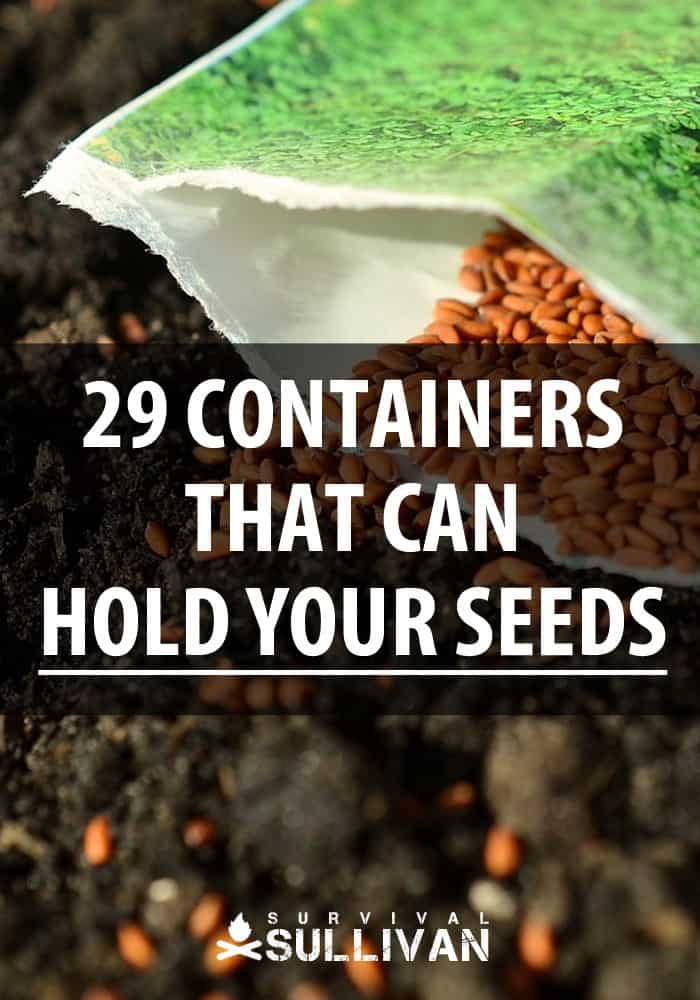

Born and raised in NE Ohio, with early memories that include grandpa teaching her to bait a hook and watching her mom, aunts, and grandmothers garden, sew, and can food, Megan is a true farm girl at heart.
For Megan, the 2003 blackout, the events of 911, and the increasing frequency of natural disasters like Hurricane Katrina, spurred a desire to be more prepared. Soon to be living off-grid, this mother of four and grandmother of ten is learning everything she can about preparedness, survival, and homesteading.

Thank you. This was helpful. Never saw this info in one place before.
Those with access to empty livestock mineral or protein tubs have a great container garden! We drill drain holes in the bottom of each tub and fill with garden soil and compost, plant the seeds, mulch once the seeds are sprouting. Most of these recycled tubs are over 12 inches deep and at least 24 inches wide. I have grown herbs, tomatoes, peppers, eggplant, collards, sweet potatoes in these tubs, with room to tuck radishes, carrots and lettuce or spinach around the main planting. Just a heads up…. container gardens require frequent watering, possibly daily.
They do not require as frequent watering if you use what you refer to above as Sub-Irrigated Planters (SIPs) also known as Self-Watering Containers (SWCs). These have a water reservoir upon which the plant’s roots can draw.
Plants also *grow better* in these containers, another reason to use them.
I’ve been saving the coffee grounds and the pods from our office Keurig. I have been removing the liner and rinsing them – and they have a drainage hole. Hoping they will be a nice size for starting individual plants.
Can you freeze dry seeds than vacuum package to extend shelf life?
I have the same question: can seeds be frozen to keep fresh? Can tin cans be used for planting seeds?